![]()
Narsarsuaq Greenland: Our Sixth Destination Fuel Stop
![]() When I got up in the morning I wasn't feeling too bad. The excitement of
the upcoming flight carried me over any rough spots cause by shortage of
sleep. Besides, we had had a good rest in Scotland before heading out.
Despite the good weather report of the previous day, the new forecast
wasn't as optimistic. A warm front was pushing up from the south,
threatening to cut us off with fog, freezing drizzle, and later freezing
rain. With no icing protection other than our pitot heat, we could not
move with known icing. The young dispatcher, however, figured we could
beat the system before it socked in, and that was all the encouragement we
needed to continue.
When I got up in the morning I wasn't feeling too bad. The excitement of
the upcoming flight carried me over any rough spots cause by shortage of
sleep. Besides, we had had a good rest in Scotland before heading out.
Despite the good weather report of the previous day, the new forecast
wasn't as optimistic. A warm front was pushing up from the south,
threatening to cut us off with fog, freezing drizzle, and later freezing
rain. With no icing protection other than our pitot heat, we could not
move with known icing. The young dispatcher, however, figured we could
beat the system before it socked in, and that was all the encouragement we
needed to continue.
![]() We took
all the fuel we could muster for the longest segment of our TransAtlantic,
and headed out. Naturally we had a head wind, and a strong one at that.
The winds were forecast at 50kts, and they were all of that as we watched
the winds whip the ocean below into a frenzy. As we flew passed Keflavik,
we watched and heard a Danish registered Dash-7 take off toward the same
destination as us. Stretching the limits of syncronicity we figured since
he was a de-Havilland and we were a de-Havilland then it only made sense
that he would share some common bond and prove to be very helpful in
getting us weather and giving us pireps, especially concerning freezing
rain. Wrong!
We took
all the fuel we could muster for the longest segment of our TransAtlantic,
and headed out. Naturally we had a head wind, and a strong one at that.
The winds were forecast at 50kts, and they were all of that as we watched
the winds whip the ocean below into a frenzy. As we flew passed Keflavik,
we watched and heard a Danish registered Dash-7 take off toward the same
destination as us. Stretching the limits of syncronicity we figured since
he was a de-Havilland and we were a de-Havilland then it only made sense
that he would share some common bond and prove to be very helpful in
getting us weather and giving us pireps, especially concerning freezing
rain. Wrong!
![]() The pilot
wouldn't give us the time of day and would not even acknowledge our calls.
We ended getting help from a loud mouth Texan ferrying a Rockwell
Commander across the "Pond." He informed us that the freezing
drizzle started at the 10,000ft level and was very light. He punched
through and got on top at 12,000ft in a few minutes. Klaus voted that we
do the same.
The pilot
wouldn't give us the time of day and would not even acknowledge our calls.
We ended getting help from a loud mouth Texan ferrying a Rockwell
Commander across the "Pond." He informed us that the freezing
drizzle started at the 10,000ft level and was very light. He punched
through and got on top at 12,000ft in a few minutes. Klaus voted that we
do the same.
![]() Klaus even
joked about how I should not worry as we had our supplementary oxygen. His
theory of oxygen was that because he was a heavy smoker, (which, much to
his credit, he never smoked in the aircraft once; partly because of his
courtesy toward me, and partly because of his fear of blowing the ferry
fuel tanks that filled the cabin and prematurely ending our journey,) and
I never smoked, that he could tough it out without oxygen while I had to
wimp it out with my mask on at anything approaching 10,000ft. Up to this
point it appeared to be the truth.
Klaus even
joked about how I should not worry as we had our supplementary oxygen. His
theory of oxygen was that because he was a heavy smoker, (which, much to
his credit, he never smoked in the aircraft once; partly because of his
courtesy toward me, and partly because of his fear of blowing the ferry
fuel tanks that filled the cabin and prematurely ending our journey,) and
I never smoked, that he could tough it out without oxygen while I had to
wimp it out with my mask on at anything approaching 10,000ft. Up to this
point it appeared to be the truth.
![]() Well, I
decided that after crossing half the world, I was not going to miss out on
seeing the incredible Greenland glacial ice-cap for myself. To stay visual
would mean VFR below the cloud layer. Somewhere in the fog of the previous
night the Twin Otter, expert-of arctic-glacial-flying, pilot had told me
that whenever you get a warm front and the cloud comes down across the
glacier it will always leave a couple hundred foot layer of clear air
beneath. Something to do with cold heavy air laying on the surface
prevents the warm air from subsiding past the compression point or some
such nonsense. At the time, around mid-night, the theory sounded fine. I
was going to find this layer and VFR it across the ice-cap. I had done
this many times in the Rockies so why not here? Klaus was not happy, but I
was determined.
Well, I
decided that after crossing half the world, I was not going to miss out on
seeing the incredible Greenland glacial ice-cap for myself. To stay visual
would mean VFR below the cloud layer. Somewhere in the fog of the previous
night the Twin Otter, expert-of arctic-glacial-flying, pilot had told me
that whenever you get a warm front and the cloud comes down across the
glacier it will always leave a couple hundred foot layer of clear air
beneath. Something to do with cold heavy air laying on the surface
prevents the warm air from subsiding past the compression point or some
such nonsense. At the time, around mid-night, the theory sounded fine. I
was going to find this layer and VFR it across the ice-cap. I had done
this many times in the Rockies so why not here? Klaus was not happy, but I
was determined.
![]() We called
back to Iceland to tell them of our decision. Basically they said,
"Fine, once out of our airspace and below MEA you will be in
uncontrolled airspace and on your own, Good Luck!" I ducked down
below the cloud layer to 9000ft and continued on. And on and on and on.
Klaus began to suspect the GPS. According to the forecast winds aloft and
our true airspeed and the indicated airspeed, we were dead on schedule.
But, time seemed to drag and drag. The ocean seemed endless. Only after
forever and a day we finally spotted the Greenland coast. My heart double
beat in excitement. Klaus let out a sigh of relief. We could see the coast
and the mountains clearly in the slightly misty air below the overcast.
We called
back to Iceland to tell them of our decision. Basically they said,
"Fine, once out of our airspace and below MEA you will be in
uncontrolled airspace and on your own, Good Luck!" I ducked down
below the cloud layer to 9000ft and continued on. And on and on and on.
Klaus began to suspect the GPS. According to the forecast winds aloft and
our true airspeed and the indicated airspeed, we were dead on schedule.
But, time seemed to drag and drag. The ocean seemed endless. Only after
forever and a day we finally spotted the Greenland coast. My heart double
beat in excitement. Klaus let out a sigh of relief. We could see the coast
and the mountains clearly in the slightly misty air below the overcast.
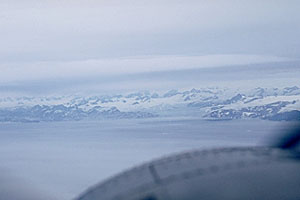
At this point Red Ericson's uncle turned
tail.
![]() The relief, however, was short lived as time continued to slow to a crawl.
Again we checked the GPS. Our ground speed, in fact, was starting to
pick-up as we fell into the lee of the huge island. Despite the extra
speed, the island, the coast, and the mountains never got any closer.
After another hour we were in a state of despair. How could we be going so
fast, our ground speed was now approaching 155knts, and not be getting any
closer? Eric the Red's uncle, the first Viking to attempt the sail to
Greenland, went through the same illusion. After many weeks of sailing
without apparent movement, he concluded that a sea monster or devil must
be holding them in place and they finally beat a hasty retreat in fear.
Eric the Red's uncle never became as famous as his nephew and for good
reason. I can't even remember his name.
The relief, however, was short lived as time continued to slow to a crawl.
Again we checked the GPS. Our ground speed, in fact, was starting to
pick-up as we fell into the lee of the huge island. Despite the extra
speed, the island, the coast, and the mountains never got any closer.
After another hour we were in a state of despair. How could we be going so
fast, our ground speed was now approaching 155knts, and not be getting any
closer? Eric the Red's uncle, the first Viking to attempt the sail to
Greenland, went through the same illusion. After many weeks of sailing
without apparent movement, he concluded that a sea monster or devil must
be holding them in place and they finally beat a hasty retreat in fear.
Eric the Red's uncle never became as famous as his nephew and for good
reason. I can't even remember his name.
![]() Klaus and
I eventually figured out that we were suffering from "Severe
Clear." A condition where clear, usually cold, air magnifies the
distant objects. The greater the distance (or altitude) the greater the
magnification. The closer you get the less the magnification. The
illusion, on the horizontal, is that you are not getting any closer. When
we finally reached the mouth of the inlet we planned to follow inland we
also realized the magnitude of the island and the approaching glacier. It
was enormous beyond our comprehension. The calving icebergs themselves
were the size of small islands. Greenland, we had to remind ourselves,
should have been a continent. Calling it an island does not do it justice.
At this point I began to get worried about my decision to go it below.
Klaus and
I eventually figured out that we were suffering from "Severe
Clear." A condition where clear, usually cold, air magnifies the
distant objects. The greater the distance (or altitude) the greater the
magnification. The closer you get the less the magnification. The
illusion, on the horizontal, is that you are not getting any closer. When
we finally reached the mouth of the inlet we planned to follow inland we
also realized the magnitude of the island and the approaching glacier. It
was enormous beyond our comprehension. The calving icebergs themselves
were the size of small islands. Greenland, we had to remind ourselves,
should have been a continent. Calling it an island does not do it justice.
At this point I began to get worried about my decision to go it below.
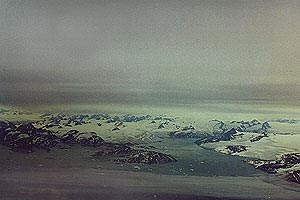
With freezing water below and freezing
rain above we try crossing the island
below the cloud layer. It does not look promising.
![]() That decision became critical as we finally approached to where we could
see where the top of the ice-cap should have been. We could not
differentiate between where the cloud ended and the ice-cap began. The two
melted into a misty white fog. The warm front was sweeping the glacier
right to the ground. So much for expert advice. We were about to fly into
a whiteout. Two incidences came to mind. The first was the Air New Zealand
747 that flew into Vinson Massif in the Antarctic during a whiteout. The
pilot simple did not distinguish the hard stuff from the soft stuff. Ice
from cloud. There were no survivors.
That decision became critical as we finally approached to where we could
see where the top of the ice-cap should have been. We could not
differentiate between where the cloud ended and the ice-cap began. The two
melted into a misty white fog. The warm front was sweeping the glacier
right to the ground. So much for expert advice. We were about to fly into
a whiteout. Two incidences came to mind. The first was the Air New Zealand
747 that flew into Vinson Massif in the Antarctic during a whiteout. The
pilot simple did not distinguish the hard stuff from the soft stuff. Ice
from cloud. There were no survivors.
![]() The other
incident was the time the Bandeirante pilot, who was quietly flying in IMC
over Greenland, noticed the aircraft beginning to mysteriously slow down.
He added power, but to no avail as it continued to slow - to a complete
stop! At that point he had to shut down and step out. He had made a
perfect full power belly landing on the top of Greenland. Luckily he was
rescued several days later, slightly embarrassed.
The other
incident was the time the Bandeirante pilot, who was quietly flying in IMC
over Greenland, noticed the aircraft beginning to mysteriously slow down.
He added power, but to no avail as it continued to slow - to a complete
stop! At that point he had to shut down and step out. He had made a
perfect full power belly landing on the top of Greenland. Luckily he was
rescued several days later, slightly embarrassed.
![]() We called
Sondre Stromfjord Greenland on the HF for weather, and we were told our
destination Narsarsuaq was going down slowly, but was still above
minimums. Sondrestrom, our alternate further north, was still in the
clear. I knew that in order to make it we would have to climb above the
cloud and through the icing layer as Klaus had originally wanted to do. If
we were to climb toward the glacier and we were to pick up icing, slowing
or stopping our climb, we could be in big trouble with the mountains
ahead. But, I decided, that if we were to climb eastbound, away from the
glacier and out over the ocean we could always descend again if need be.
In other words, we could test the waters, or ice, without any real danger.
Or so I thought.
We called
Sondre Stromfjord Greenland on the HF for weather, and we were told our
destination Narsarsuaq was going down slowly, but was still above
minimums. Sondrestrom, our alternate further north, was still in the
clear. I knew that in order to make it we would have to climb above the
cloud and through the icing layer as Klaus had originally wanted to do. If
we were to climb toward the glacier and we were to pick up icing, slowing
or stopping our climb, we could be in big trouble with the mountains
ahead. But, I decided, that if we were to climb eastbound, away from the
glacier and out over the ocean we could always descend again if need be.
In other words, we could test the waters, or ice, without any real danger.
Or so I thought.
![]() I turned
east and started our climb. Immediately entering the cloud we began to
pick up clear ice. The accumulation was fast and heavy and within a couple
thousand feet we were so loaded we could no longer climb. Even with full
defrost heat on I had only a tiny hole in the windscreen to see out of. At
13,000ft the clouds did not look any brighter above. With full power we
were going no where but down. I never even had to change altitude. I only
barely pulled the power lever back an inch and the beaver started to
plunge downward, almost out of control. I did not count on losing control.
I turned
east and started our climb. Immediately entering the cloud we began to
pick up clear ice. The accumulation was fast and heavy and within a couple
thousand feet we were so loaded we could no longer climb. Even with full
defrost heat on I had only a tiny hole in the windscreen to see out of. At
13,000ft the clouds did not look any brighter above. With full power we
were going no where but down. I never even had to change altitude. I only
barely pulled the power lever back an inch and the beaver started to
plunge downward, almost out of control. I did not count on losing control.
![]() The
control surfaces were so iced up that they were mostly ineffective. I kept
the airspeed up to prevent a stall and walked the rudders constantly to
keep the beaver's wings level. A wing drop would have been critical in
this condition. I managed to keep her right side up as we plunged down for
what seemed an eternity. Finally, at about 8,000ft we broke out. But, we
did not stop there. I was counting on the warmer air and warm rain to melt
the ice, but we continued down until nearly 4000ft over the ocean before
enough ice melted off that we could regain control and maintain our
altitude.
The
control surfaces were so iced up that they were mostly ineffective. I kept
the airspeed up to prevent a stall and walked the rudders constantly to
keep the beaver's wings level. A wing drop would have been critical in
this condition. I managed to keep her right side up as we plunged down for
what seemed an eternity. Finally, at about 8,000ft we broke out. But, we
did not stop there. I was counting on the warmer air and warm rain to melt
the ice, but we continued down until nearly 4000ft over the ocean before
enough ice melted off that we could regain control and maintain our
altitude.
![]() Klaus,
having just gone through a wild joy ride, was not happy. He kept saying as
we continued to plunge, "We have to get control of ourselves, we have
to get control of ourselves." I must give him credit, as there is
nothing more difficult for a pilot than to be in the right seat and have
to trust someone else. As the ice melted and we started our climb back up
to just below the cloud, Klaus finally regained his composure, but
repeating out loud. "No, I have to get control of myself, I must get
control of myself." At that point, Klaus broke out the oxygen and
took a few minutes of long deep breaths to clear his head. I could not
help but be amused at the irony of his teasing me earlier about my use of
oxygen. I had been on it the whole time above 10,000ft.
Klaus,
having just gone through a wild joy ride, was not happy. He kept saying as
we continued to plunge, "We have to get control of ourselves, we have
to get control of ourselves." I must give him credit, as there is
nothing more difficult for a pilot than to be in the right seat and have
to trust someone else. As the ice melted and we started our climb back up
to just below the cloud, Klaus finally regained his composure, but
repeating out loud. "No, I have to get control of myself, I must get
control of myself." At that point, Klaus broke out the oxygen and
took a few minutes of long deep breaths to clear his head. I could not
help but be amused at the irony of his teasing me earlier about my use of
oxygen. I had been on it the whole time above 10,000ft.
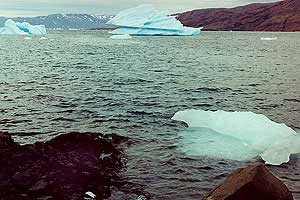
The pure isolation and severity of the
inlets made our blood chill.
![]() Now we had the big decision to make. With the ice on our antenna we had
lost contact with Greenland and the weather updates. Considering the time
and fuel wasted, and the deteriorating condition of the weather at our
destination, I decided to head back to Iceland. As much as I hated the
idea, I figured that we had to admit defeat. I made the decision, in part,
not to scare Klaus any further, but Klaus argued otherwise. "There is
no way in hell that I am going back across that ocean only to run our of
fuel 20 miles short of the airport. No way." He wanted to head to our
alternate further up north. We were positive the weather would still be
holding there. Klaus put in the co-ordinates in the GPS, and my heart sank
as we realized that it was 800 miles further north. If we headed there,
especially after losing the HF contact and without a updated weather
report, we were committing ourselves. From there we would have no
alternative. Our fuel would be too low to go on.
Now we had the big decision to make. With the ice on our antenna we had
lost contact with Greenland and the weather updates. Considering the time
and fuel wasted, and the deteriorating condition of the weather at our
destination, I decided to head back to Iceland. As much as I hated the
idea, I figured that we had to admit defeat. I made the decision, in part,
not to scare Klaus any further, but Klaus argued otherwise. "There is
no way in hell that I am going back across that ocean only to run our of
fuel 20 miles short of the airport. No way." He wanted to head to our
alternate further up north. We were positive the weather would still be
holding there. Klaus put in the co-ordinates in the GPS, and my heart sank
as we realized that it was 800 miles further north. If we headed there,
especially after losing the HF contact and without a updated weather
report, we were committing ourselves. From there we would have no
alternative. Our fuel would be too low to go on.
![]() Suddenly
the image struck me. Our destination was only 100 miles away. If we could
break through the cloud layer we could still try for our original
destination and keep the northern base of Sondrestrom as our alternate as
planned. How? Picture this. A classic warm front moving south to north.
Where we were the cloud base was now down to 8000ft. Tops about 15,000ft.
Icing from 8000ft to about 13,000ft where after that it would be too cold
to further collect. That 5000ft of icing layer is what we tried to break
through and failed. The classic warm front, remember? Remember the drawing
on the IFR portion of your ATPL exam? Of course.
Suddenly
the image struck me. Our destination was only 100 miles away. If we could
break through the cloud layer we could still try for our original
destination and keep the northern base of Sondrestrom as our alternate as
planned. How? Picture this. A classic warm front moving south to north.
Where we were the cloud base was now down to 8000ft. Tops about 15,000ft.
Icing from 8000ft to about 13,000ft where after that it would be too cold
to further collect. That 5000ft of icing layer is what we tried to break
through and failed. The classic warm front, remember? Remember the drawing
on the IFR portion of your ATPL exam? Of course.
![]() All we had
to do was fly about 100 miles northwest and then punch through. And we
did. As we got further north the cloud base above us rose and got colder.
The tops got higher, but at that altitude the moisture was pure ice
crystals. Best of all, the icing layer would only extend from about the
base of 11,000ft to the freezing level of about 13,000ft. The theory
worked perfectly. We began our climb through the cloud and again we began
to pickup ice. But, by the time it started to accumulate, however, it was
too cold to collect any further. Klaus was yelling, "I can see blue
sky, keep her going." We broke out at 16,000ft and leveled out at
16,500ft. Sunshine and blue blue sky. We could see heaven.
All we had
to do was fly about 100 miles northwest and then punch through. And we
did. As we got further north the cloud base above us rose and got colder.
The tops got higher, but at that altitude the moisture was pure ice
crystals. Best of all, the icing layer would only extend from about the
base of 11,000ft to the freezing level of about 13,000ft. The theory
worked perfectly. We began our climb through the cloud and again we began
to pickup ice. But, by the time it started to accumulate, however, it was
too cold to collect any further. Klaus was yelling, "I can see blue
sky, keep her going." We broke out at 16,000ft and leveled out at
16,500ft. Sunshine and blue blue sky. We could see heaven.
![]() Soon the
ice sublimated off in the cold and we were able to reestablish contact
with Sondrestrom. They had been calling, but weren't too worried. The best
news was that our destination weather was still holding out on the
minimum. We could try an approach there. We continued on at 16,500ft --
both on oxygen.
Soon the
ice sublimated off in the cold and we were able to reestablish contact
with Sondrestrom. They had been calling, but weren't too worried. The best
news was that our destination weather was still holding out on the
minimum. We could try an approach there. We continued on at 16,500ft --
both on oxygen.
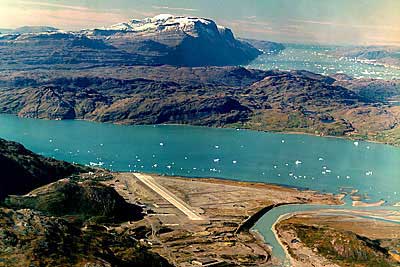
Ok, the weather was not this good when we
got there.
![]() Our approach wasn't exactly going to be easy either. The airport was at
sea-level, deep inside a fjord, and surrounded by 9,000ft mountains and
glaciers. The approach is to establish a hold over the beacon, at 16,500ft
and circle down in the hold, using the DME to establish the turns, and
break out somewhere before the minimum of 3500ft. That in itself would not
be the problem. The icing would. If we were to collect ice on the way down
and then not break out at the minimum, how would we get back up again?
Back to square one.
Our approach wasn't exactly going to be easy either. The airport was at
sea-level, deep inside a fjord, and surrounded by 9,000ft mountains and
glaciers. The approach is to establish a hold over the beacon, at 16,500ft
and circle down in the hold, using the DME to establish the turns, and
break out somewhere before the minimum of 3500ft. That in itself would not
be the problem. The icing would. If we were to collect ice on the way down
and then not break out at the minimum, how would we get back up again?
Back to square one.
![]() The tower
gave us an actual ceiling, however, of 3500ft. We were allowed to make the
approach. What could go wrong? Just to be sure of the turns I put the
co-ordinates of the DME into the GPS. I did a turn at 16,000ft to get the
feel for it and then started down. Down and down. Again time stood still.
At 500ft a minute it would take 32 minutes to get down. I wanted to get
through the icing layer as fast as possible so I pulled the power and let
her fall. As the ice built up we lost the DME. The fast descent had let
the ice build up on the belly and blocked the DME antenna. Without it we
would be blind as there was no timing on these turns. GPS to the rescue. I
readjusted my scan to the GPS reading, which I had doubled checked earlier
as corresponding, and flew the rest of the approach. At 3800ft we still
could not see the ground. At 3500ft I was getting ready to check my
descent, when Klaus rang out "I've got visual, keep her going, keep
her going, yes! We made it."
The tower
gave us an actual ceiling, however, of 3500ft. We were allowed to make the
approach. What could go wrong? Just to be sure of the turns I put the
co-ordinates of the DME into the GPS. I did a turn at 16,000ft to get the
feel for it and then started down. Down and down. Again time stood still.
At 500ft a minute it would take 32 minutes to get down. I wanted to get
through the icing layer as fast as possible so I pulled the power and let
her fall. As the ice built up we lost the DME. The fast descent had let
the ice build up on the belly and blocked the DME antenna. Without it we
would be blind as there was no timing on these turns. GPS to the rescue. I
readjusted my scan to the GPS reading, which I had doubled checked earlier
as corresponding, and flew the rest of the approach. At 3800ft we still
could not see the ground. At 3500ft I was getting ready to check my
descent, when Klaus rang out "I've got visual, keep her going, keep
her going, yes! We made it."
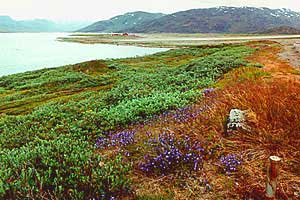
Safely down on the runway we can look
north east
toward the mountains we crossed to get here.
![]() The best part came when I called visual and asked for a visual that would
take me for a little tour down the valley before landing. The tower asked
for a special request from the Dash-7 taxiing out. Would you allow the
Danish Prime Minister's Dash-7 to taxi out and take-off while you are on
your approach? Otherwise they will have to wait. Klaus and I looked at
each other. You mean that asshole who wouldn't relay us the weather.
Forget it. So we had the pleasure of making that Danish prima-donna wait
it out for little brother.
The best part came when I called visual and asked for a visual that would
take me for a little tour down the valley before landing. The tower asked
for a special request from the Dash-7 taxiing out. Would you allow the
Danish Prime Minister's Dash-7 to taxi out and take-off while you are on
your approach? Otherwise they will have to wait. Klaus and I looked at
each other. You mean that asshole who wouldn't relay us the weather.
Forget it. So we had the pleasure of making that Danish prima-donna wait
it out for little brother.
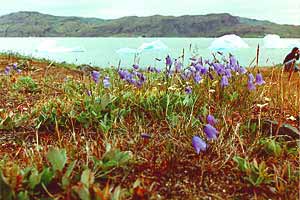
The land is cold. The land is beautiful.
![]() That night in the only hotel in town, Klaus and I treated ourselves to
caribou steaks and red wine. The only other guests in the hotel were the
Danish Prime Minister's party and their Greenland hosts. It was a special
occasion and they had all the tables lined up just across from our single
table. The conversation in Danish was lively and jovial. They were clearly
having a good time. After a particularly animated speech the hosts
presented the Prime Minister (or the PM's wife, I never did figure that
out) with a beautiful full length seal skin coat. She tried it on and
modeled it for all to behold and received an appreciating round of
applause.
That night in the only hotel in town, Klaus and I treated ourselves to
caribou steaks and red wine. The only other guests in the hotel were the
Danish Prime Minister's party and their Greenland hosts. It was a special
occasion and they had all the tables lined up just across from our single
table. The conversation in Danish was lively and jovial. They were clearly
having a good time. After a particularly animated speech the hosts
presented the Prime Minister (or the PM's wife, I never did figure that
out) with a beautiful full length seal skin coat. She tried it on and
modeled it for all to behold and received an appreciating round of
applause.
![]() Ok, it was
our second bottle of red wine, but Klaus could not help himself in making
a comment. To be sure I would hear him over the commotion he said very
loudly, in English, "We would appreciate her modeling the coat a
whole lot more if she wasn't wearing anything underneath!" The room
suddenly became quiet. An awkward silence was followed by a cough and a
snicker. Klaus stared at me in disbelief. He forgot. They could all also
speak perfect English. One of the party chuckled and nodded in agreement,
"Yaah, that would make it more interesting." And everyone broke
out in laughter. The Canadian bush pilots strike again.
Ok, it was
our second bottle of red wine, but Klaus could not help himself in making
a comment. To be sure I would hear him over the commotion he said very
loudly, in English, "We would appreciate her modeling the coat a
whole lot more if she wasn't wearing anything underneath!" The room
suddenly became quiet. An awkward silence was followed by a cough and a
snicker. Klaus stared at me in disbelief. He forgot. They could all also
speak perfect English. One of the party chuckled and nodded in agreement,
"Yaah, that would make it more interesting." And everyone broke
out in laughter. The Canadian bush pilots strike again.

I get dressed up to have dinner with the
Prime Minister.
Story and Images by John S Goulet
![]() Goose Bay Canada Across
to Labrador our entry into Canada
Goose Bay Canada Across
to Labrador our entry into Canada
![]()
The attitude indicator will take you back to the ferry flight introduction page.
Where all our flying is cross country.
Last modified on Aprin 21st, 2013.
© Virtual Horizons, 1996.
